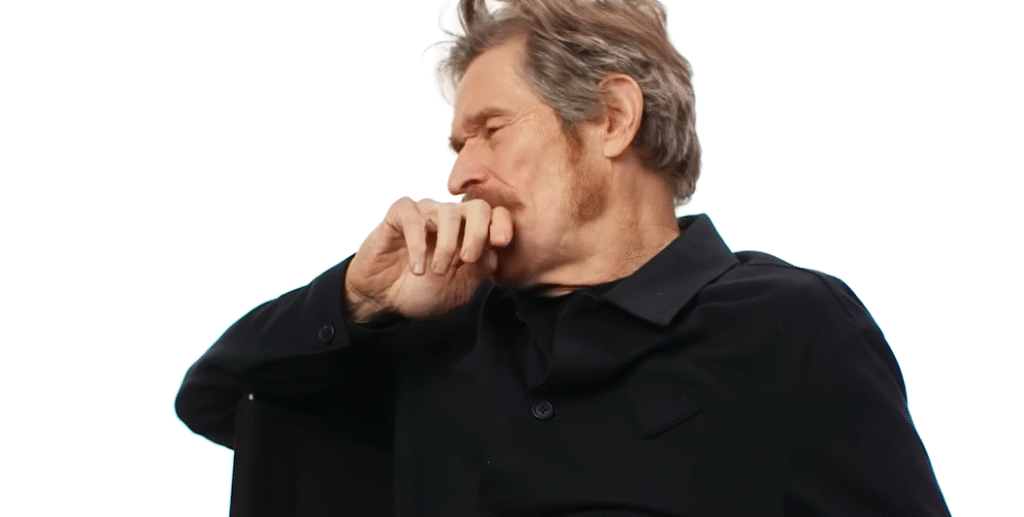Standing at a height that is still hotly contested in fan forums, Willem Dafoe remains an intriguing example of the relationship between stardom and stature. He is listed as 5′ 7″ tall in the majority of databases, including IMDb, but remarks from co-stars, viewers, and live appearances indicate otherwise. It’s interesting to note that a previous article from the late 1980s claimed Dafoe was 5’9″ and noticeably thin, weighing 145 pounds—possibly a reflection of his younger, more erect posture in his early film careerThe Truth About Nurkic Height Compared to NBA Giants.
The height debate has been rekindled in recent days by Reddit threads and social media posts, especially after a street-style video of Dafoe in New York gained widespread attention. Many were distracted by his fashion-forward demeanor while wearing all-black Prada, but some astute commenters pointed out that he looked noticeably shorter than others who were listed at 5’7″, such as actor Chris Redd. This sparked renewed speculation, with some observers confidently asserting he’s no taller than 5’5”, while others argue he might still stand at a solid 5’7”—but perhaps only in well-fitted shoes.
The difference is particularly noticeable when contrasting red carpet pictures with those of actors like Tom Holland, Robert Pattinson, and Oscar Isaac. Dafoe’s height appears to change based on posture, footwear, and angle. Due to this visual discrepancy, estimates have ranged widely, from 5’6″ on a good day to a more generous 5’9″ at the height of his career. Despite being 5’7″, one former grocery clerk recalled Dafoe as “noticeably shorter than me.” Even fans who met him in person have shared contradictory stories.
However, in light of Hollywood’s changing landscape, Dafoe’s prominence is still largely unrelated to his dominance as an actor. Shorter male leads have become much more visible over the last ten years thanks to performances that go beyond their physical presence. Despite being shorter than the conventional six-foot standard, celebrities like Tom Holland, Daniel Radcliffe, and Robert Downey Jr. have all built extraordinarily successful careers. However, this dynamic was invented by Dafoe long before it was accepted as the standard in the industry.
Willem Dafoe: Bio & Personal Details
| Detail | Information |
|---|---|
| Full Name | William James “Willem” Dafoe |
| Date of Birth | July 22, 1955 |
| Place of Birth | Appleton, Wisconsin, USA |
| Height | Varies by source: 5’7” (170 cm), 5’8” (173 cm), or 5’9” (175 cm) |
| Spouse | Giada Colagrande (married since 2005) |
| Children | Jack Dafoe |
| Notable Roles | Norman Osborn / Green Goblin (Spider-Man), Vincent van Gogh, Thomas Wake |
| Awards | 4 Academy Award Nominations, Golden Globe, Venice Volpi Cup, Berlin Golden Bear |
| Theater Roots | Original member of The Wooster Group |
| Latest Projects | Nosferatu, Beetlejuice Beetlejuice, Kinds of Kindness |
| Verified Source | IMDb Official Page |

Dafoe’s ability to control the screen with such ease and his tendency to appear larger than life despite his diminutive stature are what make him so captivating. His portrayal of a stormy seafarer opposite Robert Pattinson in The Lighthouse was so intense and powerful that viewers were moved by the emotional gravity rather than the height differences. Dafoe’s presence remained remarkably dominant, even in scenes where he was in the same frame as co-stars who were noticeably taller.
It is especially evident from looking at his career path that directors have never shied away from casting him in intense, powerful, and leadership roles. He became the moral center of a chaotic war zone in Platoon. He rewrote the definition of a comic book villain with terrifying nuance in Spider-Man. He vanished into Vincent van Gogh’s delicate genius in At Eternity’s Gate. Additionally, he combined brilliant scientific madness with gothic eccentricity in Poor Things. These performances rely on Dafoe’s extraordinarily potent transformational talent rather than height.
Dafoe has established a career path that is remarkably clear in its intention: challenge convention, embrace complexity, and push performance boundaries. This has been made possible through strategic collaborations with auteur filmmakers such as Lars von Trier, Wes Anderson, and Robert Eggers. His decision to prioritize substance over show has made him a symbol of defiance against the shallow standards of the industry. And because of this, his career has endured and remained relevant as he approaches his seventies.
Dafoe has considerably lessened the stigma associated with height in male leads by continuing to be adaptable, modest, and creatively bold. He has become an icon due to his reputation as an actor who can carry both independent art films and international blockbusters. Directors now cast based on psychological range, emotional depth, and dynamic storytelling rather than silhouette. Even though it happened gradually, that change has influenced casting choices in recent years and prompted a more comprehensive reinterpretation of charisma.
Dafoe’s career provides a noticeably better model for medium-height or shorter actors navigating an industry that has historically been fixated on tall, broad-chested alpha males. His self-assurance, flexibility, and emotional intelligence are key components of his success. His lifelong devotion to art over image is evident even in his involvement with experimental theater, especially during his thirty years with The Wooster Group. His participation in the Venice Biennale, where he was recently appointed Artistic Director of the theater department, exemplifies that philosophy to this day.
Dafoe’s name has come up in award talks and cultural conversations about masculine identity, authenticity, and aging during recent film festivals. Even in ensemble casts with stars decades younger than him, he still stands out, demonstrating that emotional reach is more important for longevity in Hollywood than physical height.
